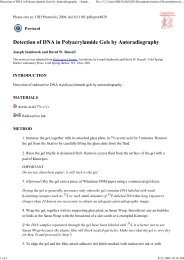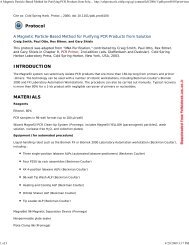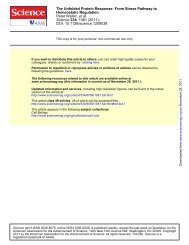news and views© 2010 Nature America, Inc. All rights reserved.The authors provide a tool, Grid analysis oftime-series expression (GATE), which usesa correlation-based clustering algorithm forthe comparison and visualization of multilayeredtime-course data sets as interactiveimages or movies 6 . Using GATE, Lu et al. 1conducted temporal and dynamic analysesamong different regulatory layers with clusteringof genes that are regulated in a similarpattern, revealing connections betweenthe regulatory mechanisms underlying EScell fate changes. Their analysis reveals thetemporal order of regulatory network configurationsafter a single perturbation, thedownregulation of Nanog.The study by Lu et al. 1 does not plumbthe full complexity of cell fate determination.Rather, it should be viewed as a first step inwhat will have to be a series of attempts toincorporate multiple data sets into a comprehensiveunderstanding of gene regulation. Luet al. 1 introduced an artificial perturbationin ES cells by knocking down a single criticalfactor. Surely, during normal development,changes in multiple regulators may occursimultaneously. The necessity to oversimplifythe regulatory problem is evident inother ways. For example, different kinds ofhistone modifications involved in positiveor negative gene regulation that are likely tobe functionally relevant were not examined.Moreover, several forms of regulation werenot studied, including post-transcriptional/translational regulation by microRNAs 7 ,post-translational modification of proteins,and modulation of protein localization.A truly comprehensive accounting of thedynamics of fate changes will require considerationof these additional regulatorylayers.Tracking cell-state transitions by multiplehigh-throughput assays, as well as the integrationof such observations in a systematicfashion, is a monumental task. Ultimately,one would like to develop ways to use thekinds of large data sets analyzed by Lu etal. 1 to predict the specific outcomes in EScells of other regulatory perturbations.Given the heterogeneity in gene expressionamong cells 8,9 , it is likely that additionaltechnologies will be needed, such as quantitativemonitoring of gene expression andof epigenetic modifications at the single-celllevel. The development of readily accessibledatabases for storing large data sets fromvarious platforms, as well as user-friendlyanalysis and visualization tools, will also benecessary to facilitate the comprehensiveunderstanding of multilayered gene regulatorynetworks during dynamic cellularprocesses.COMPETING INTERESTS STATEMENTThe authors declare no competing financial interests.1. Lu, R. et al. Nature 462, 358–362 (2009).2. MacArthur, B.D., Ma’ayan, A. & Lemischka, I.R.Cold Spring Harb. Symp. Quant. Biol. 73, 211–215(2008).3. Mitsui, K. et al. Cell 113, 631–642 (2003).4. Chambers, I. et al. Cell 113, 643–655 (2003).5. de Sousa Abreu, R., Penalva, L.O., Marcotte, E.M. &Vogel, C. Mol. Biosyst. 5, 1512–1526 (2009).6. MacArthur, B.D., Lachmann, A., Lemischka, I.R. &Ma’ayan, A. Bioinformatics 26, 143–144 (2010).7. Marson, A. et al. Cell 134, 521–533 (2008).8. Singh, A.M., Hamazaki, T., Hankowski, K.E. & Terada,N. Stem Cells 25, 2534–2542 (2007).9. Chambers, I. et al. Nature 450, 1230–1234 (2007).nature biotechnology volume 28 number 2 february 2010 147
esearch highlights© 2010 Nature America, Inc. All rights reserved.Adaptive optics in microscopyLight microscopy of wholetissues is often complicated bydistortions caused by the opticalinhomogeneities in the biologicalspecimen. By borrowing andadapting approaches from astronomy,Ji et al. develop adaptive optics tocorrect aberrations. The correctionis achieved using a ‘spatial light modulator’, an active opticalelement that permits adjustment of the tilt and phase of thelight passing through more than 100 individual segments at therear pupil of the objective lens. The extent of the modulation foreach of the segments is determined by an algorithm that firstmeasures and corrects the spatial deflections caused by thesample inhomogeneities and then corrects errors in the phase foreach of the segments. The improvements in signal strength, imagefidelity and resolution that can be achieved using adaptive opticsare demonstrated by imaging fluorescent beads and neurons in300- to 500-µm thick brain slices. The technique can be used toimprove the performance of many wide-field and point scanningmicroscopy technologies, including the latest super resolutiontechniques that are especially sensitive to optical aberrations.(Nat. Methods advance online publication, December 27, 2009,doi:10.1038/nmeth.1411)MEDigestible plant wallsRigid cell walls give plants strength, but they also confound attemptsby plant genetic engineers to convert woody plants to biofuels.Creating rigid cell walls requires intermolecular cross-linking ofpectins, facilitated by de-methyl-esterified homogalacturonans(HGA). Releasing fermentable sugars from plant cell walls, on theother hand, requires environmentally unfriendly chemicals or hightemperatures. Now Lionetti et al. show that plants transformedwith enzymes that inhibit the de-esterification of HGA polymersare more accessible to enzymatic degradation. Twice as much sugarwas released from the leaves of transgenic Arabidopsis thaliana plantsoverexpressing fungal polygalacturonase, 60% more when plantswere transformed with a pectin methylesterase inhibitor (PMEI).To show that pectin architecture was being modified, the researchersreacted the transgenic leaves with an antibody that binds to blocksof de-esterified HGA and found reduced binding to the transgenicplants. They were able to replicate these findings in wheat (Triticumdurum), an industrially important plant. Finally, they found thatArabidopsis expressing PMEI had more biomass than the controlplants (due to cell expansion). This contrasts with polygalacturonase-expressingtransgenic plants that generally have less biomass.The group suggests that regulating polygalacturonase expression intime and space might prevent the loss of biomass. (Proc. Natl. Acad.Sci. USA 107, 616–621, 2010)LDMicroarray SNP detection heats upGresham et al. have discovered new rules to enhance the accuracyof DNA microarrays. These rules substantially improve the abilityWritten by Kathy Aschheim, Laura DeFrancesco, Markus Elsner &Craig Makof probes on the array to bind the correct sequence when similarsequences are present in a sample, which is particularly useful whenidentifying variation at the level of single nucleotide polymorphisms(SNPs). The authors varied different experimental parameters anddiscovered that a probe is best able to discriminate SNPs when itsmelting temperature (T m ) is ~2–5 °C below the temperature used tohybridize samples to the array. This knowledge was used to designmicroarrays with probes between 16 and 35 nt in length—in contrastto the common practice of making uniform-length probes—such that all probes have the same melting temperature, and thus allachieve optimal performance at the same hybridization temperature,~2–5 °C above the T m . These so called isothermal microarrays outperformedconventional arrays at identifying heterozygous SNPs.The use of an optimum hybridization temperature in tandem withuniform T m probes (varying in length) may be useful for designingarrays for other applications. (Proc. Nat. Acad. Sci. USA, publishedonline January 8, 2010, doi:10.1073/pnas.0913883107) CMCo-workers in transcription factoriesChromosome conformation capture on a chip (4C) is capable ofdetecting remote chromatin interactions on a genome-wide scale.Schoenfelder et al. use a modification of this method to analyze thegenome-wide repertoire of transcriptional interactions associatedwith globin genes in erythroid tissues. Their technique, dubbedenhanced ChIP-4C, first cross-links proteins and DNA to generate asnapshot of the spatial organization of the nucleus. However, the 4Cassay is then modified to incorporate an RNA polymerase–recognizingantibody that identifies DNA that is near to, but not necessarily onthe same chromosome as, actively transcribed copies of the ‘bait’ gene(that is, globin). Subsequently, a biotinylated bait-specific DNA probeis used to enrich for ‘prey’ sequences, which are cross-linked to thebait. The DNA in the enriched sample is then identified by microarrayanalysis. Analysis of the promoters of actively transcribed globingenes in mouse cells reveals a transcription factor, Klf1, requiredfor regulating genes in globin-containing ‘transcription factories’ inthe nucleus. The approach should facilitate understanding of howgenes are brought together in the nucleus to regulate their expression.(Nat. Genet. 42, 53–61, 2010)CMPlatelet allyBiotech has no shortage of new ideas on how to staunch bleeding.Where traditional therapy amounts to little more than the applicationof pressure or absorbent material, research in the past decade hassought to enhance the body’s intrinsic mechanisms of coagulation.Allogeneic platelets, recombinant clotting factors, red blood cellsdisplaying the cell-adhesive RGD sequence, self-assembling peptides,liposomes and a block copolymer of hemoglobin and fibrinogenare some of the strategies that have been tried, but none hasdemonstrated adequate safety and efficacy. Now Bertram et al. haveproposed to control bleeding with “synthetic platelets,” or nanoparticlesconsisting of poly(lactic-co-glycolic acid)-poly-l-lysine blockcopolymer cores carrying polyethylene glycol chains that are cappedwith RGD sequences. Working with a rat model of major injury tothe femoral artery, the authors found that the nanoparticles bindto platelets and boost clot formation more effectively than existingtherapies. Moreover, the nanoparticles were rapidly cleared fromthe circulation, and no adverse effects were observed. (Sci. Transl.Med., published online December 16, 2009, doi:10.1126/scitranslmed.3000397)KA148 volume 28 number 2 february 2010 nature biotechnology
- Page 3 and 4: volume 28 number 2 february 2010COM
- Page 5 and 6: in this issue© 2010 Nature America
- Page 7 and 8: © 2010 Nature America, Inc. All ri
- Page 10 and 11: NEWS© 2010 Nature America, Inc. Al
- Page 12 and 13: NEWS© 2010 Nature America, Inc. Al
- Page 14 and 15: NEWS© 2010 Nature America, Inc. Al
- Page 16 and 17: © 2010 Nature America, Inc. All ri
- Page 18 and 19: © 2010 Nature America, Inc. All ri
- Page 20 and 21: © 2010 Nature America, Inc. All ri
- Page 22 and 23: NEWS feature© 2010 Nature America,
- Page 24 and 25: uilding a businessComing to termsDa
- Page 26 and 27: uilding a business© 2010 Nature Am
- Page 28 and 29: correspondence© 2010 Nature Americ
- Page 30 and 31: correspondence© 2010 Nature Americ
- Page 32 and 33: correspondence© 2010 Nature Americ
- Page 34 and 35: correspondence© 2010 Nature Americ
- Page 36 and 37: case studyNever againcommentaryChri
- Page 38 and 39: COMMENTARY© 2010 Nature America, I
- Page 40 and 41: COMMENTARY© 2010 Nature America, I
- Page 42 and 43: patents© 2010 Nature America, Inc.
- Page 44 and 45: patents© 2010 Nature America, Inc.
- Page 46 and 47: news and viewsChIPs and regulatory
- Page 48 and 49: news and viewsFrom genomics to crop
- Page 50 and 51: news and views© 2010 Nature Americ
- Page 54 and 55: e s o u r c eRational association o
- Page 56 and 57: e s o u r c e© 2010 Nature America
- Page 58 and 59: e s o u r c e© 2010 Nature America
- Page 60 and 61: e s o u r c e© 2010 Nature America
- Page 62 and 63: © 2010 Nature America, Inc. All ri
- Page 64 and 65: B r i e f c o m m u n i c at i o n
- Page 66 and 67: i e f c o m m u n i c at i o n sAUT
- Page 68 and 69: lettersa1.5 kb hVPrIntron 112.5 kbA
- Page 70 and 71: letters© 2010 Nature America, Inc.
- Page 72 and 73: letters© 2010 Nature America, Inc.
- Page 74 and 75: l e t t e r sReal-time imaging of h
- Page 76 and 77: l e t t e r sFigure 2 Time-lapse li
- Page 78 and 79: l e t t e r s© 2010 Nature America
- Page 80 and 81: l e t t e r sRational design of cat
- Page 82 and 83: l e t t e r s© 2010 Nature America
- Page 84 and 85: l e t t e r s© 2010 Nature America
- Page 86 and 87: sample fluorescence was measured as
- Page 88 and 89: careers and recruitmentFourth quart
















